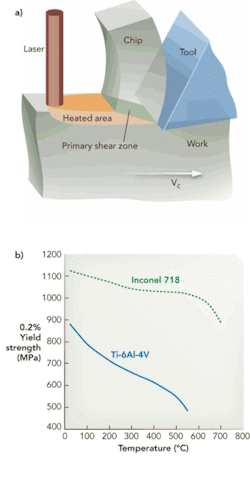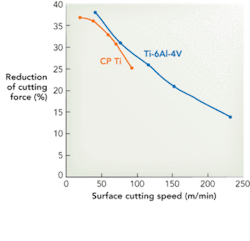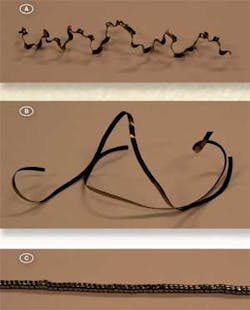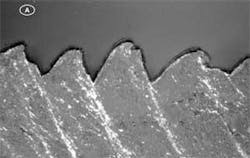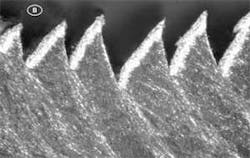S. Sun and M. Brandt
Combining laser and turning offers significant improvement in the machining of titanium workpieces
Titanium and its alloys are used extensively in aerospace applications because of their excellent properties at room and elevated temperatures. However, the cost of machining titanium-alloy components is extremely high compared to that of machining aluminum-alloy components because of the relatively low machining speed and short tool life.
The poor machinability of titanium and its alloys is due to their inherent properties, such as low thermal conductivity leading to high cutting temperature, chemical reactivity with almost all tool materials at high temperature, high hardness at elevated temperature, and low modulus of elasticity. Therefore, conventional machining of titanium alloys is a time-consuming and consumable (for example, cutting tool and coolant) intensive process.
Improving the machinability of titanium alloys is a research topic of much interest, with a number of approaches reported with varied results, such as cryogenic cutting, high-pressure coolant, rotary-tool turning, and minimum quantity lubrication.
Another technique is thermally enhanced machining, in which an external heat source, such as a laser beam, heats and softens the workpiece locally in front of the cutting tool and allows difficult-to-machine materials to be machined with greater ease (see Fig. 1).1
Positive results from laser-assisted machining have been reported for machining ceramics and also for cutting nickel and cobalt-based alloys and stainless steel in terms of longer tool life, lower cutting forces, smoother machined surface, and increased material removal rate.1-4 However, contradictory results have been reported on thermally enhanced machining of titanium alloys. Despite the achieved lower cutting forces,5 shorter tool life is reported, and the Widmanstatten structure, due to plasma preheating, is still present in the machined surface, which might affect the fatigue life of the machined parts.6
We have conducted a series of dry turning experiments using a tungsten carbide tool on commercially pure and titanium alloy (Ti6Al4V) with the assistance of a fiber-delivered Nd:YAG laser beam. The effects of laser-beam arrangement, power, and cutting speed on the reduction of cutting forces in the x (feed), y (thrust), and z (cutting) directions and chip formation have been examined.
It was observed that the laser had a significant effect on the cutting performance. It not only affected the amplitude of the cutting forces but also their fluctuation, reducing both significantly. The reduction of amplitude of cutting forces was due to the softening of the workpiece by the laser’s local heating and resulted in a lower friction force between the tool and workpiece.
The reduction of cutting forces dramatically decreased with increasing cutting speed because of the shorter interaction time between the laser beam and workpiece (see Fig. 2). However, the reduction in cutting forces of 26% was still significant at the cutting speed of 93 m/min.
Chip formation
The material removed by cutting is referred to as machining chips. The morphology of a chip is the result of deformation during chip formation and is determined by the characteristics of the workpiece, tool geometry, and machining parameters. The segmented chip is a common chip morphology in conventional machining of titanium alloys at almost any speed.
The segmentation is believed to be due to the growth of cracks from the outer surface of the chip7,8 or adiabatic shear-band formation,9,10 which is caused by localized shear deformation because of thermal softening at the cutting edge and the limited slip planes of titanium alloys. At the given cutting tool geometry, the cutting speed for the onset of shear localization is inversely proportional to the depth of cut and is very low for conventional machining of titanium alloys.9 The chips formed during the machining process were of three types (see Fig. 3).
null
The depth of the saw-teeth and segment spacing were observed to characterize the difference in chip formation between conventional machining and laser-assisted machining (LAM) at different cutting speeds (see Fig. 4). Under conventional cutting, the deformation across the chip width was uniform and the chip segment spacing was independent of cutting speed, but the depth of the saw teeth increased with cutting speed. However, the laser beam makes the deformation across the chip width nonhomogeneous. The shear deformation in the center of the laser beam is larger at lower cutting speed, but smaller at higher cutting speed; that is, the chip made by LAM is sharper than that by conventional machining in lower cutting speed. Furthermore, the segment spacing increases and segmentation distance decreases with increasing cutting speed.
A conclusion is drawn that temperature at the primary shear zone plays an important role in the chip segmentation because the shear localization that is apparent in the segmented chip can only occur in the presence of a softening mechanism, making deformation of an already deformed region easier than that of an undeformed region. The higher the temperature at the primary shear zone (achieved by increasing cutting speed in conventional cutting, or increasing laser power, reducing the distance between laser beam and tool and lower cutting speed in LAM), the higher the tendency for the chip to become serrated.
Unlike the appearance of shear localization in chip segmentation in conventional cutting, shear localization is not clearly found in the serrated chip with LAM. The chip made by conventional cutting at high speed (93 m/min) shows a significant localized shear band and very high hardness fluctuation across these shear bands because of the work hardening. With LAM, the shear bands become wide and the amplitude of hardness fluctuation becomes smaller for distance between tool and beam of 20-mm, shear bands disappear and hardness distribution becomes homogenous in chip with distance between tool and beam of 10 mm.
The wide shear band or its disappearance is the reason for the lower dynamic cutting forces observed in LAM despite the appearance of chip segmentation. Hence, the chip segmentation is not the direct result of the formation of localized shear bands and does not necessarily produce chatter during machining. This also translates into a much smoother machined surface. The common defects such as grain pullout and material buildup found in conventional machining were not found in the LAM surface because the chip was removed with lower stress.
Advantages
To date, research on laser-assisted turning of commercially pure Ti6Al4V has confirmed the following process advantages:
- Reduction of cutting forces-primarily affected by the cutting speed, laser power density, and distance between the tool and laser beam. The lower cutting force at higher cutting speed in LAM means that it is possible to increase the titanium alloy removal rate at the same lathe power
- Lower dynamic forces due to the continuous plastic deformation during chip formation, leading to reduction of chatter
- Less sharp segmented chip produced at high cutting speed because of lower heat generated at the primary shear zone
- Lower hardness near the machined surface compared with conventional cutting due to the lower shear deformation and
- Smooth surface finish because of lower dynamic cutting force.
Further work is in progress to explore the feasibility of laser-assisted milling of these alloys.
Acknowledgments
The authors gratefully acknowledge the CAST Cooperative Research Centre for permission to publish this work and the financial support received under project No. 3-01-290. The CAST Cooperative Research Centre was established and is supported under the Australian Government Cooperative Research Centres Programme.
References
- G. Chryssolouries, N. Anifantis, and S. Karagianni, “Laser Assisted Machining: An Overview, Journal of Manufacturing Science & Engineering,” Transactions of the ASME 119, 766 (1997).
- M. Anderson, R. Patwa, and Y. C. Shin, “Laser-assisted machining of Inconel 718 with an economic analysis,” Intl J. Machine Tools & Manufacture 46 (14), 1879 (2006).
- W. B. Salem et al., “Laser Assisted Turning during Finishing Operation Applied to Hardened Steels and Inconel 718, in Laser Assisted Net Shape Engineering, Proc. LANE ‘94, M. Geiger and F. V. Meisenbach Bamberg, 455 (1994).
- J. Walter and R. Ritzi, “Increasing tool life by laser assisted turning,” in Laser Assisted Net Shape Engineering 4, Proc. LANE 2004, M.Geiger and A. O. Meisenbach Bamberg, 1157 (2004).
- S. Rajagopal et al., “Machining aerospace alloys with the aid of a 15 kW laser,” J. Appl. Metalworking 2 (3), 170 (1982).
- . L. LaSalle, et al., “Plasma assisted milling heat-resistant superalloys,” J. Manufacturing Science and Engineering, Transactions of the ASME 126, 274 (2004).
- T. Obikawa and E. Usui, “Computational machining of titanium alloy - Finite element modeling and a few results,” J. Manufacturing Science and Engineering, Transactions of the ASME 118, 208 (1996).
- A. Vyas and M. C. Shaw, “Mechanics of saw-tooth chip formation in metal cutting,” J. Manufacturing Science and Engineering, Transactions of the ASME 211, 163 (1999).
- R. Komanduri and Z.-B. Hou, “On the thermoplastic shear instability in the machining of a titanium alloy (Ti6Al4V),” Metallurgical and Materials Transactions 33A, 2995 (2002).
- J. Barry, G. Byrne, and D Lennon, “Observations on chip formation and acoustic emission in machining Ti-6Al-4V alloy,” Intl J. Machine Tools & Manufacture 41, 1055 (2001).
S. Sun and M. Brandt are with the Industrial Laser Applications Laboratory, IRIS Swinburne University of Technology, Melbourne Australia. Contact Milan Brandt at [email protected].
